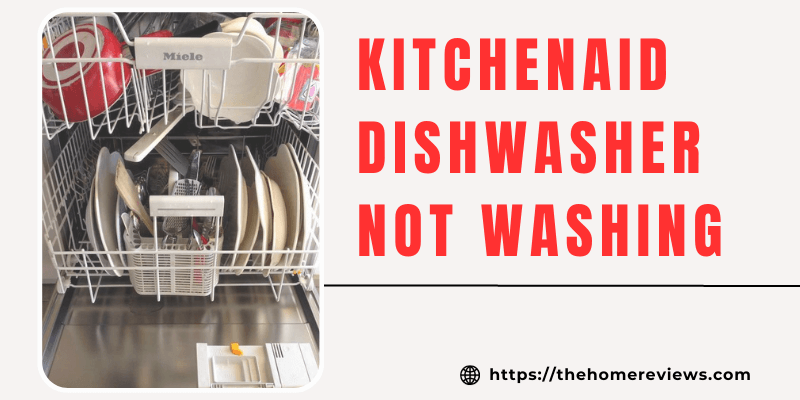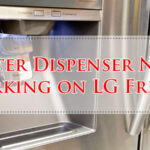If your Kitchenaid dishwasher is not washing, it could be due to clogged filters and/or spray nozzles. Overcrowding the dishwasher racks can also prevent water from reaching and cleaning each item.

Other potential causes include a faulty pressure switch, temperature regulator, and door switch. Additionally, a lack of water flow or a clogged drain can be common problems. To troubleshoot, remove any blockages in the line, check the water inlet valve, and inspect the pump motor.
Consider these factors when diagnosing and addressing the issue with your Kitchenaid dishwasher.
Common Causes Of A Kitchenaid Dishwasher Not Washing Properly
If your KitchenAid dishwasher is not washing properly, it could be due to clogged filters or spray nozzles. Other causes to consider include overloaded or improperly loaded dishes, water supply issues, and outdated appliances. Ensure these factors are addressed for optimal washing performance.
During the heating cycle, there could be a problem with the pressure switch, temperature regulator, or door switch. These components play a crucial role in initiating the washing process. If any of them are faulty, the dishwasher may fill with water but fail to start cleaning.
Another common issue that can cause a KitchenAid dishwasher not to wash properly is a lack of water flow or a clogged drain. If there isn’t enough water entering the dishwasher or if the drain is blocked, the dishes won’t get properly cleaned.
Blockages in the water line or a broken pump motor can also result in a dishwasher not washing effectively. The water line carries water to the dishwasher, and if it’s obstructed, the dishwasher won’t receive an adequate water supply. Similarly, if the pump motor is broken, it won’t be able to circulate water effectively, leading to poor cleaning performance.
To summarize, the common causes of a KitchenAid dishwasher not washing properly are:
Clogged Filters and Spray Nozzles:
- The accumulation of food particles and debris can block the filters and spray nozzles, preventing proper water flow and distribution.
- Regularly cleaning and unclogging these components can help improve the dishwasher’s cleaning performance.
Overloaded or Overlapping Dishes:
- When dishes are loaded too closely together or overlap, water may not be able to reach all the items, resulting in inadequate cleaning.
- Give each item enough individual space and avoid overcrowding the dishwasher to ensure proper water circulation.
Faulty Pressure Switch, Temperature Regulator, or Door Switch:
- If these components are malfunctioning, the dishwasher may fill with water but fail to initiate the washing cycle.
- Professional repair or replacement of these faulty parts may be necessary to restore proper functionality.
Lack of Water Flow or a Clogged Drain:
- Insufficient water supply or a blocked drain can prevent the dishwasher from washing the dishes effectively.
- Ensure that the water supply is sufficient and check for any blockages in the drain to resolve this issue.
Blockages in the Water Line or a Broken Pump Motor:
- Obstructions in the water line or a malfunctioning pump motor can hinder the proper circulation of water, resulting in poor cleaning performance.
- Clear any blockages in the water line and consider professional repair or replacement of the pump motor if necessary.
By addressing these common causes, you can troubleshoot and resolve issues with your KitchenAid dishwasher not washing properly.
1. Check For Clogged Filters And Spray Nozzles
If your Kitchenaid dishwasher is not washing, one possible cause could be clogged filters and spray nozzles. Make sure to check these components, as well as other potential issues like improper loading of dishes, to ensure proper water flow and effective cleaning.
Why is my KitchenAid dishwasher not washing? There could be several reasons for a dishwasher not cleaning, but one common issue is clogged filters and spray nozzles. By addressing this problem, you might be able to get your dishwasher back to its efficient cleaning performance.
Here are the steps to check for clogged filters and spray nozzles:
Remove the baskets and the bottom basket.
- Take out the upper and lower baskets from your KitchenAid dishwasher.
- Set them aside to access the mechanisms underneath.
Clean the Macerator and Spinner:
- Locate the macerator and spinner, which are responsible for grinding up food particles.
- Use a soft brush or toothbrush to remove any debris or buildup on these parts.
- Ensure that both the macerator and spinner are free from blockages.
Clean the filter screen and check the macerator cap.
- Locate the filter screen, usually situated at the bottom of the dishwasher.
- Remove the filter screen carefully and rinse it under running water to remove any accumulated particles.
- Inspect the macerator cap for any clogs or damage.
- Make sure the macerator cap is securely fastened.
By following these steps and cleaning your KitchenAid dishwasher’s filters and spray nozzles, you may be able to improve its washing performance. Remember to do regular maintenance checks to prevent future clogs and maintain a clean dishwasher.
2. Ensure Proper Water Flow
If your KitchenAid dishwasher is not washing properly, one of the reasons could be a lack of water flow. This can be caused by clogged filters or spray nozzles. Make sure to check and clean these components to ensure proper water flow and optimal cleaning performance.
Check for Clogged Spray Arms:
- Clogged spray arms can cause your Kitchenaid dishwasher to not wash properly. Here’s how to check for and clean any clogs:
- Remove the spray arms by twisting them counterclockwise and pulling them up.
- Rinse the spray arms under running water to remove any debris or buildup.
- Inspect the spray arms for any clogs or blockages. Use a toothpick or small brush to gently remove any obstructions.
- Once clean, reattach the spray arms by twisting them clockwise until they are securely in place.
Inspect and clean the bottom spray arm, cone filter, and spray:
- The bottom spray arm, cone filter, and spray system in your Kitchenaid dishwasher play a crucial role in water flow. Make sure to inspect and clean them regularly with these steps:
- Remove the bottom spray arm by unscrewing the retaining nut and lifting it off.
- Check the spray arm for any cracks or damage. Replace it if necessary.
- Clean any debris or food particles from the spray arm using warm, soapy water and a soft brush.
- Remove the cone filter located beneath the spray arm and rinse it thoroughly to remove any residue.
- Inspect the spray system for any blockages or clogs. Use a toothpick or small brush to remove any obstructions.
Clean the lower spray arm and check the water temperature.
- The lower spray arm and water temperature are key factors in ensuring proper cleaning in your Kitchenaid dishwasher. Follow these steps to maintain them effectively:
- Remove the lower spray arm by unscrewing the retaining nut and lifting it off.
- Clean the spray arm using warm, soapy water and a soft brush to remove any buildup or debris.
- Check the water temperature setting on your dishwasher. It should be set to a minimum of 120°F (49°C) for optimal cleaning performance.
- If the water temperature is too low, adjust the water heater accordingly to ensure it reaches the required temperature for effective cleaning.
Remember, proper water flow is essential for a Kitchenaid dishwasher to wash dishes efficiently. By checking for clogged spray arms, inspecting and cleaning the bottom spray arm, cone filter, and spray system, as well as cleaning the lower spray arm and checking the water temperature, you can address potential issues and ensure your dishwasher is working at its best.
3. Address Faulty Components
When it comes to a Kitchenaid dishwasher not washing, a possible solution is to address faulty components. This could include checking for clogged filters and spray nozzles, as well as examining the pressure switch, temperature regulator, and door switch for any issues.
By replacing any malfunctioning parts, you can ensure that your dishwasher is functioning properly and washing dishes effectively.
Examine the Water Duct, Pump, and Dirty Water Sensor:
- Check the water duct: Inspect the water duct for any clogs or blockages that may be preventing water from reaching the dishes. If you find any debris, use a small brush or toothpick to remove it.
- Test the pump: The dishwasher pump is responsible for spraying water onto the dishes. If the pump is faulty, it may not be providing enough pressure to effectively clean the dishes. Check for any signs of damage or wear, and consider replacing it if necessary.
- Clean the dirty water sensor: The dirty water sensor is designed to detect when the water is dirty and needs to be drained. If the sensor is dirty or covered in residue, it may not be working properly. Use a soft cloth to clean the sensor and ensure that it is free from any debris.
Check the garbage disposal and water pump:
- Inspect the garbage disposal: If your KitchenAid dishwasher is connected to a garbage disposal, make sure it is clear of any food particles or debris. A clogged garbage disposal can prevent proper drainage and affect the dishwasher’s ability to clean.
- Test the water pump: The water pump is responsible for circulating water throughout the dishwasher. If the pump is not functioning correctly, it can lead to poor cleaning performance. Check for any signs of damage or blockage, and consider replacing the pump if necessary.
Reassemble the dishwasher after troubleshooting:
- After addressing the faulty components, reassemble the dishwasher by carefully placing all the parts back in their respective positions.
- Make sure all the connections are secured and tight, including the water supply and drain hoses.
- Double-check that the water duct, pump, dirty water sensor, and garbage disposal are all properly installed.
- Once everything is reassembled, test the dishwasher to see if the cleaning performance has improved.
Remember, troubleshooting and addressing faulty components can significantly improve your KitchenAid dishwasher’s cleaning performance. By following these steps, you can tackle common issues that may be hindering the washing process.
Frequently Asked Questions For Kitchenaid Dishwasher Not Washing
Why is my Kitchenaid dishwasher not washing?
A KitchenAid dishwasher not washing could be due to clogged filters or spray nozzles and overcrowding of dishes.
Why Is My Kitchenaid Dishwasher Filling With Water But Not Washing?
A KitchenAid dishwasher not washing could be due to clogged filters and/or spray nozzles. Other causes may include overcrowding the racks or improper loading of dishes.
What Is the Most Common Problem With A Kitchenaid Dishwasher?
The most common problem with a KitchenAid dishwasher is a lack of water flow or a clogged drain.
What Causes a Dishwasher Not To Wash?
A dishwasher may not wash properly due to clogged filters, dirty spray nozzles, or overcrowding of dishes.
Why is my Kitchenaid dishwasher not washing?
A dishwasher not being cleaned could be due to clogged filters and/or spray nozzles. Make sure to check for these issues.
Conclusion
If you’re experiencing issues with your KitchenAid dishwasher not washing properly, there are a few common causes to consider. Clogged filters and spray nozzles can prevent water from reaching and cleaning each item. Additionally, loading the dishwasher with items that don’t have enough individual space or are overlapping can also hinder proper cleaning.
It’s important to make sure that the dishwasher is loaded correctly to ensure optimal performance. Other potential causes of a KitchenAid dishwasher not washing include a faulty pressure switch, temperature regulator, or door switch. If these components are malfunctioning, they may need to be replaced with new ones.
Troubleshooting a KitchenAid dishwasher not washing involves checking for clogged filters, proper loading techniques, and potentially replacing faulty components. By addressing these issues, you can ensure that your dishwasher runs efficiently and effectively, leaving your dishes clean and sparkling.





